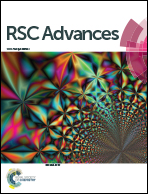Evolution of carbon impurities in solution-grown and sputtered Al:ZnO thin films exposed to UV light and damp heat degradation†
Abstract
The electrical properties of polycrystalline ZnO thin films with grain boundary limited charge transport depend significantly on the degree of chemisorbed adsorbate (CxOyHz) coverage at grain boundaries and on the surface. Here we report the evolution of carbon adsorbates in chemical bath deposited (CBD) aluminum doped ZnO (AZO) thin films during post-deposition UV light exposure and degradation in humid atmosphere. As CBD AZO intrinsically contains carbon impurities stemming from the addition of citrate during the deposition, sputtered AZO is examined in parallel as a nominally carbon-free reference. UV illumination decomposes citrate impurities in CBD AZO, but the residual carbon compounds are not effectively removed from the bulk part of the layer. At the same time, charge-trapping oxygen species at grain boundaries are desorbed, increasing the carrier density and mobility. Exposure to humid atmosphere decreases the electrical conductivity of CBD AZO, which is caused by the chemisorption of environmental oxygen species and the formation of zinc carbonate.



 Please wait while we load your content...
Please wait while we load your content...